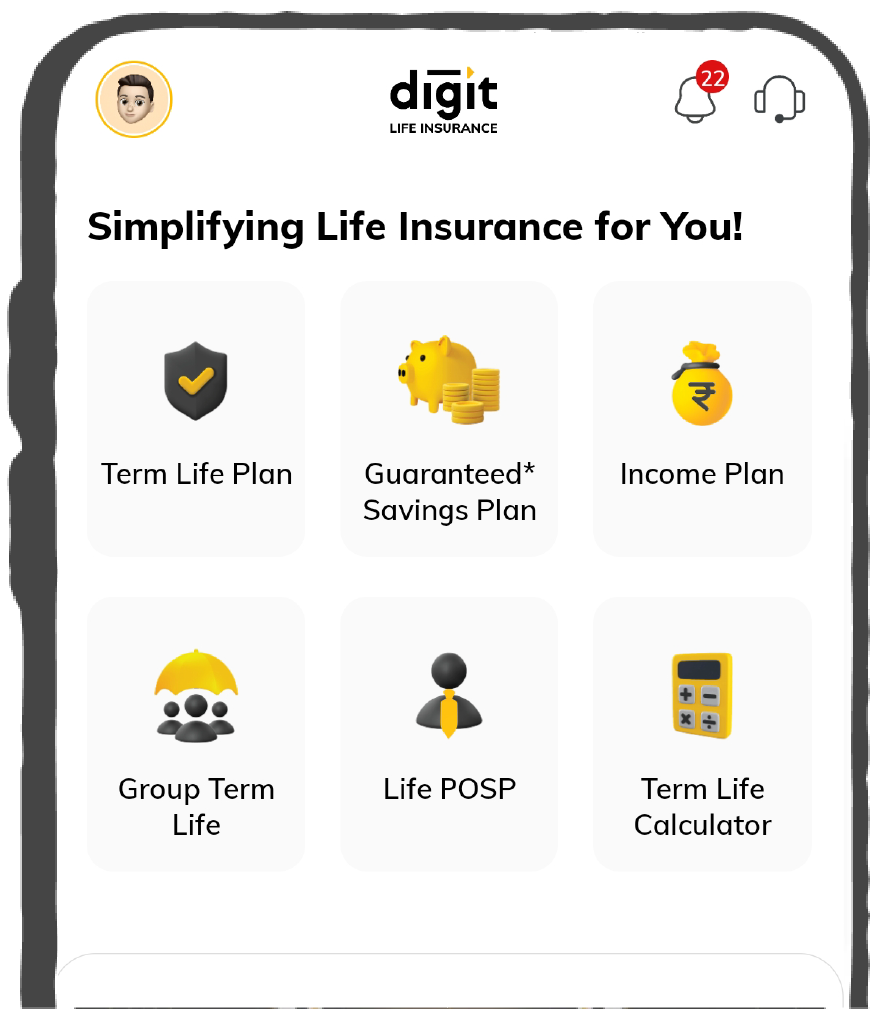Term Life Insurance for Cancer Patients

Cancer is a challenging illness that affects not only the patient but also their entire family. It often requires long-term treatment, including medications and hospital stays, which can be very costly and stressful.
Instead of using up all your savings on treatment, consider buying a term insurance plan with critical illness coverage, specifically for cancer patients, early in your career. This article explains how a term life insurance policy can benefit individuals at risk of cancer.

Table of Contents

Is Term Insurance Available for Cancer Patients?
Why is Term Insurance Important for Cancer Patients?
Term insurance can provide essential financial support for cancer patients and their families, addressing needs like:
- Ensures loved ones are financially supported if the primary earner passes away unexpectedly.
- Helps cover medical expenses, mortgages, and loans, preventing additional financial strain on the family.
- Provides comfort to patients, knowing their family's financial future is secure, allowing them to focus on their treatment.
- Serves as an additional layer of protection for individuals with existing life insurance policies during challenging times.
Can Cancer Patients Buy Term Insurance?

For Newly Diagnosed Patients
If you have just been diagnosed with cancer, getting term insurance can be challenging. Here are some key points to understand:
- Limited Options: Most insurance companies are unlikely to offer you term insurance right after your diagnosis. This is because they consider you a higher risk during this time.
- Waiting Period: Typically, you must wait until your treatment is finished. Moreover, many insurers require that you remain cancer-free for a specific period before they will consider your application.
- Varied Requirements: The required waiting period can differ between insurance providers and also depends on the type of cancer with which you have been diagnosed.
For Cancer Survivors
If you have completed your treatment and are recovering, you may have a better chance of obtaining term insurance. Here’s what you usually need:
- Completion of Treatment: You must have completed your cancer treatment before applying for insurance.
- Cancer-Free Period: Insurers typically require proof that you have been cancer-free for a specified duration, typically around five years.
- Medical Records: It is essential to provide detailed medical records that demonstrate your recovery and current health status.
- Stable Health: Your health condition must be stable. This means you should not be experiencing any ongoing medical issues related to your past cancer diagnosis.
How Does Term Insurance for Cancer Patients Work?
Term insurance for cancer patients works similarly to standard term insurance but with some specific considerations due to the health condition. Here's a breakdown of how it typically works:
Application and Evaluation
When a person is diagnosed with cancer, they often consider obtaining term insurance for added security. During the application process, they are subjected to a detailed medical evaluation.
Risk Assessment
The insurance provider evaluates medical information, including the stage of cancer and overall health factors.
Premium Quotation
The policyholder receives a quotation based on the findings of the risk assessment. However, the premium is likely higher than that of a healthy individual.
Death During the Policy Term
If the policyholder dies during the coverage period, their beneficiaries can submit a claim.
Death Benefit Payout
Upon filing the claim, the policyholder’s family receives the death benefit, which helps them settle financial obligations and provides financial support during a challenging time.
Different Scenarios of Term Insurance for Cancer Patients
Mahesh Already has Term Insurance with Critical Illness Coverage
Mahesh, a 50-year-old father of three, had a term life insurance policy with critical illness coverage. When diagnosed with prostate cancer, he received a lump sum payout, which covered his medical bills and supported his family during treatment.
This financial relief allowed him to focus on recovery without stress. His policy also continued to provide death benefits, ensuring his family’s future was secure.
Kritika Does Not Have Term Insurance and is Diagnosed with Cancer
Kritika, a 42-year-old single mother, had always intended to get life insurance but never got around to it. When she was diagnosed with ovarian cancer, she realised the urgency of securing her family’s financial future.
However, finding term life insurance after a cancer diagnosis was challenging. After research, she secured a guaranteed-issue life insurance policy with higher premiums and lower coverage. This policy did not require a medical exam.
Despite its limitations, the policy provided some financial protection for her children. Kritika’s decision ensured her family would have support if she were no longer around.
Types of Term Insurance Plans for Cancer Patients
Several life insurance policies may be available to cancer patients, each with its features, benefits, and limitations. Here are some of the most common options:
Waiting Periods in Term Insurance for Cancer Patients
When applying for term insurance, cancer patients may encounter specific waiting periods based on their diagnosis and treatment history. Here’s a simple breakdown:
Early-Stage Cancers - These are cancers that are detected at an early point and usually have a better prognosis. If you have been treated for early-stage cancer, most insurance companies may require you to wait about 2 to 5 years after your treatment ends before you can get coverage.
Advanced-Stage Cancers - This refers to cancers that have progressed more significantly at the time of diagnosis, often with a poorer prognosis. For those who have had advanced-stage cancer, the waiting period can be significantly longer, typically ranging from 5 to 10 years after treatment completion.
Multiple Cancer Occurrences - This applies to individuals who have been diagnosed with more than one type of cancer over their lifetime. If you have had multiple cancers, insurance providers may impose longer waiting periods or reject your application altogether, depending on the insurer’s policies.
Waiting Period in Term Insurance for Cancer Survivors
Waiting periods refer to the time an individual must typically wait after treatment before their insurance will cover certain benefits related to their cancer. Here’s a breakdown of common waiting periods for different types of cancer:
Note: These waiting periods are general guidelines and can differ based on the policies of individual insurance companies. Check with their insurance provider to understand the exact terms that apply to their situations.

Tips for Improving Chances of Term Insurance Approval for Cancer Patients
Securing term insurance as a cancer patient can be challenging, but taking certain steps can enhance your chances of getting approved. Here are some key areas to focus on:
- Keep a complete record of all your treatments, including dates, types of therapies (like chemotherapy or radiation), and any medications you are taking. This information helps insurers understand your medical history.
- Maintain documentation of all follow-up appointments with your healthcare providers. These reports often provide insights into your current health status and recovery progress.
- Schedule regular medical evaluations to monitor your health. This shows insurers that you are proactive about your condition and care.
- If your doctor has prescribed cancer marker tests, keep the results organised. These tests can provide important information about your current health and any signs of recurrence.
- If you smoke or consume alcohol, quitting can significantly improve your overall health and may positively influence your insurance application.
- Always adhere to your doctor’s advice regarding medications and lifestyle modifications. This demonstrates your commitment to managing your health.
Riders Available with Term Insurance for Cancer Patients
Riders and add-ons for cancer patients in term insurance can provide additional coverage and benefits tailored to their specific needs. Here are some typical riders and add-ons that could be included:
Critical Illness Rider
Critical illness rider pays out a lump sum upon diagnosing a specific critical illness, such as cancer. It provides financial assistance to cover medical fees and other treatment-related expenses for each day spent in the hospital, helping to offset out-of-pocket costs during treatment.
Waiver of Premium Rider
If the insured is diagnosed with a serious illness (like cancer) and is unable to work, the waiver of premium rider waives future premium payments while maintaining coverage. It helps prevent policy lapses during difficult times.
Terminal Illness Rider
Terminal illness rider enables the insured to access a portion of the death benefit if diagnosed with a terminal illness, helping to cover expenses or leave a financial legacy while still alive.
Challenges Cancer Patients Face in Obtaining Term Insurance
Premiums Price
The premium amount often depends on factors like the type, stage, and treatment history of cancer. Based on these, insurers may charge higher premiums for cancer patients, reflecting the increased risk of mortality.Limited Coverage Options
Cancer patients may find that certain types of life insurance, especially traditional term insurance, have restrictions or exclusions for individuals with cancer. Some companies may only offer limited coverage or shorter terms.Waiting Periods
Insurance companies may impose a waiting period for patients with cancer. During this period, usually one to three years, the policy may not pay out the full death benefit if the insured passes away due to cancer.Strict Underwriting Criteria
Many insurance companies have strict criteria, which can result in the denial of coverage for those with certain types or stages of cancer.Lack of Awareness
Many cancer patients and survivors are unaware of the insurance options available to them or may assume they won’t qualify, which can lead to missing out on important coverage options.FAQs about Term Insurance for Cancer Patients
Can cancer patients buy term insurance?
What factors determine eligibility for term insurance for cancer patients?
How does a cancer diagnosis affect term insurance premiums?
What are the exclusions or limitations for cancer patients in term insurance?
Is there a waiting period for term insurance coverage for cancer patients?
What type of term insurance policies are available for cancer patients?
Can cancer patients add critical illness riders to their term insurance?
What are the key differences between cancer-specific insurance and term insurance with a cancer rider?
What steps should cancer patients take before applying for term insurance?
How does the stage of cancer affect the approval of term insurance?
Other Important Articles Related to Term Insurance
Latest News
Read More










